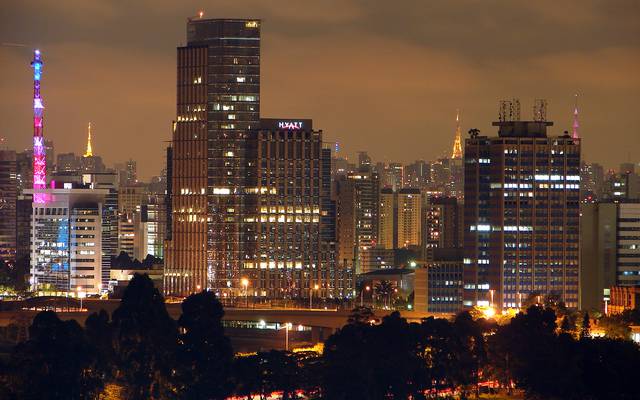 São Paulo is the largest city in Brazil, with a municipality population of 12.1 million, and about 21.3 million in its metropolitan region - the second most populous of the Southern Hemisphere. It is the capital of the Southeastern state of São Paulo, and also a beehive of activity that offers a jovial nightlife and an intense cultural experience. São Paulo is South America's major economic center and possesses the 10th largest GDP in the world, though poverty, especially in the suburbs, is still widespread due to the blatant social inequality. Historically attractive to immigrants and to Brazilians from other states, it has a unique cultural identity formed by combining Portuguese and African roots (common to the entire country) with other influences, in particular Italian, Arab and Japanese.
São Paulo is the largest city in Brazil, with a municipality population of 12.1 million, and about 21.3 million in its metropolitan region - the second most populous of the Southern Hemisphere. It is the capital of the Southeastern state of São Paulo, and also a beehive of activity that offers a jovial nightlife and an intense cultural experience. São Paulo is South America's major economic center and possesses the 10th largest GDP in the world, though poverty, especially in the suburbs, is still widespread due to the blatant social inequality. Historically attractive to immigrants and to Brazilians from other states, it has a unique cultural identity formed by combining Portuguese and African roots (common to the entire country) with other influences, in particular Italian, Arab and Japanese.
São Paulo, or Sampa as it is also often called, is also probably one of the most underrated cities tourism-wise, often overshadowed by other places in the Brazilian sun & beach circuit such as Rio de Janeiro and Salvador. It is in fact a great city to explore, with an impressive (and almost intimidating) skyline, unpredictable neighbourhoods and architecture, a vibrant culture and arts (in particular street art) scene, not to mention the world-class restaurants and diverse regional and international cuisine available to all tastes. If there is a major attraction to this city, it is the excellent quality of its restaurants and the variety of cultural activities on display.
Just south of the city, lies the Parque Estadual Serra do Mar (part of the Atlantic Forest South-East Reserves, a UNESCO World Heritage Site), a mountain range covered by lush rainforest that faces the coast and provides various ecotourism options.
São Paulo is the most visited city of Brazil, but mostly because of business and event tourism, with many of the visitors not taking much effort to explore the city. Those who do so may, however, discover one of the most complex and fascinating cities of the world, where even nearby areas may look and feel like a different city, due to São Paulo's staggering social inequality and variety of cultural influences, and its lack of comprehensive urban planning.
For instance, if you walk from one end to another of Rua Augusta (which later becomes Rua Colômbia and Avenida Europa), starting from Downtown, you will pass through:
- One of the city's hottest nightlife areas in Baixa Augusta
- A vibrant cultural and business area surrounding Avenida Paulista
- A variety of shopping options in the area surrounding Rua Oscar Freire
- The green, affluent low-rise neighbourhood of Jardim América
- A stream of expensive car shops in Jardim Europa
- The modern business district in Av. Faria Lima and the ultra-affluent neighbourhood of Itaim
Although the first impression might be that of a grey concrete jungle, soon it becomes apparent that the city has a great number of pockets of beauty, and fantastic places (and not always expensive) to dine, drink and hang out.
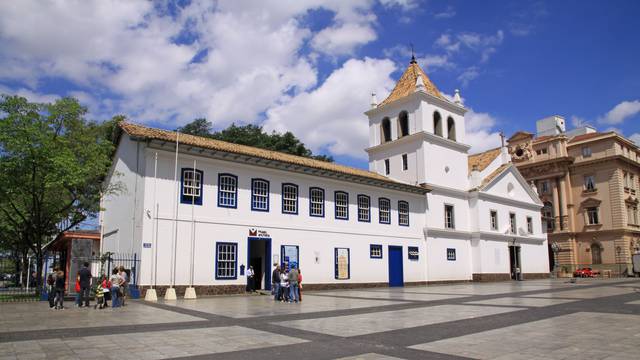
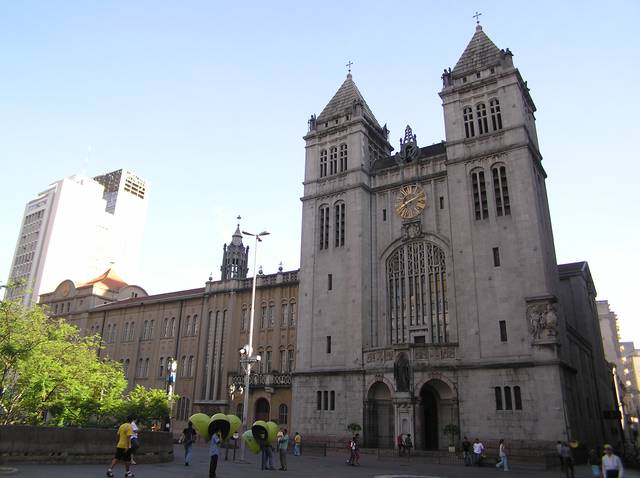
Native American Chief Tibiriçá and the Jesuit priests José de Anchieta and Manuel de Nóbrega founded the village of São Paulo de Piratininga on 25 January 1554—Feast of the Conversion of Paul the Apostle. Along with their entourage, the priests established a mission named Colégio de São Paulo de Piratininga aimed at converting the Tupi-Guarani native Brazilians to the Catholic religion. São Paulo's first church was constructed in 1616, and it was located where today is the Páteo do Colégio (metrô: Sé or São Bento station).
São Paulo was designated a city in 1711. In the 19th century, it experienced a flourishing economic prosperity, brought about chiefly through coffee exports, which were shipped abroad from the port of neighbouring city Santos. After 1881, waves of immigrants from Italy, Japan, and other European and Middle Eastern countries, such as Syria and Lebanon immigrated to São Paulo State due to the coffee production boom. Enslavement of Africans was coming to an end, due to British pressure, as the British Empire wished to introduce its machinery and industrialized products to Brazil. The government was also concerned with the fact that the population of black people was greater than that of whites, and, in an effort to "bleach the race," gave incentives to European nationals of countries such as Italy, Germany, Lithuania, Ukraine, Poland, Portugal, and Spain to immigrate. Thus, after Emancipation, with the influx of European labor and failure on the part of the racist system to include African-Brazilians, black people became increasing unemployed and discriminated against. By the beginning of the 20th century, the coffee cycle had already plummeted due to, among other factors, a sharp decline in international coffee prices and competition from other nations. The local entrepreneurs then started investing in the industrial development of São Paulo, attracting new contingents of overseas immigrants to the city. Many of those entrepreneurs had Italian, Portuguese, German, and Syro-Lebanese Christian descent such as the Matarazzo, Diniz, and Maluf.
However, due to competition with many other Brazilian cities, which sometimes offer tax advantages for companies to build manufacturing plants in situ, São Paulo's main economic activities have gradually left its industrial profile in favour of the services industry over the late 20th century. The city is nowadays home to a large number of local and international banking offices, law firms, multinational companies, advertising firms and consumer services.
Many major international and Brazilian companies have offices in São Paulo, and the Bovespa stock exchange index (Ibovespa) is considered one of the most important Latin American market indices abroad.
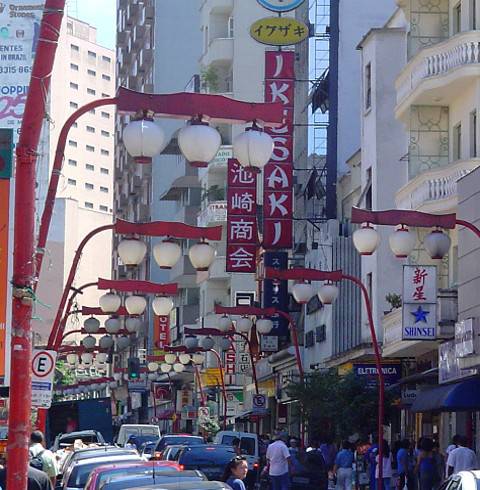 Don't be surprised at the diversity of Paulistanos. For example, São Paulo is home to the largest Japanese population outside of Japan. It is not uncommon to see businesses and churches being conducted by Chinese and Korean-Brazilians in Liberdade, which began as an Italian district, became Japanese, and now is heavily populated by Koreans and Chinese. The city's Italian influence is also very strong, with about 6 million people in the metropolitan area having Italian background. The large Arab and Jewish communities are also well represented in all levels of society, from art to real estate businesses, and notably in politics.
Don't be surprised at the diversity of Paulistanos. For example, São Paulo is home to the largest Japanese population outside of Japan. It is not uncommon to see businesses and churches being conducted by Chinese and Korean-Brazilians in Liberdade, which began as an Italian district, became Japanese, and now is heavily populated by Koreans and Chinese. The city's Italian influence is also very strong, with about 6 million people in the metropolitan area having Italian background. The large Arab and Jewish communities are also well represented in all levels of society, from art to real estate businesses, and notably in politics.
The citizens of São Paulo have a reputation as hard-working and industrious or shallow money-grubbers. It is common to hear that the people in São Paulo work while the rest of Brazil relaxes; even though many say this, it is plainly wrong. It is a fact, nonetheless, that the city of São Paulo alone actually contributes 15 percent of the country's gross national product (45 percent if the entire São Paulo state is taken into account).
But when Paulistanos are not working, they are clubbing. The city nightlife is as intense as it gets, which makes going to a club a total must-do.
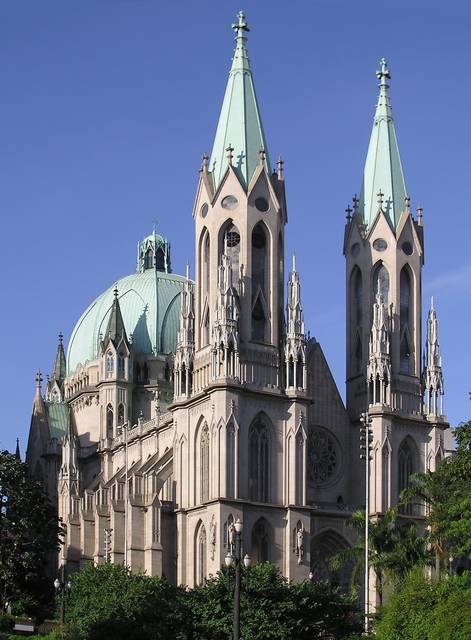 São Paulo's basic spot for orientation should be Avenida Paulista. From there, it's pretty easy to reach every single spot in town, be it by bus or underground transport. It lies between the neighborhoods of Bela Vista and Jardim Paulista. Av. Paulista is also within walking distance to Centro and Ibirapuera Park, which makes it the perfect place to start a walking tour.
São Paulo's basic spot for orientation should be Avenida Paulista. From there, it's pretty easy to reach every single spot in town, be it by bus or underground transport. It lies between the neighborhoods of Bela Vista and Jardim Paulista. Av. Paulista is also within walking distance to Centro and Ibirapuera Park, which makes it the perfect place to start a walking tour.
However, central São Paulo is a very large area, and travelling from one spot to another may require that you take a cab or public transport. To find out the general direction where you are, see the street signs, as it is colour-coded:
- Sé/República (in Downtown): White street plate.
All other areas have blue street plates, and a bottom stripe on the following colours:
- Expanded Center: Grey (Expanded Center means the area limited by the Tietê river on the North, the Pinheiros river on the West, Avenida dos Bandeirantes on the South and Avenida Salim Farah Maluf on the East)
- Northwest: Light Green
- North: Dark Blue
- Northeast: Yellow
- East: Red
- Southeast: Dark Green
- South: Light Blue
- Southwest: Purple
- West: Orange
To find the direction of Downtown (most precisely Praça da Sé), just follow the direction of decreasing street numbers. That doesn't work, however, in the Santo Amaro subprefecture (South Central), neither in the Far South region; in these areas, decreasing numbers lead to Largo 13 de Maio.
Sé/República (in [[São Paulo/Downtown|Downtown]]): White street plate.
São Paulo is on a mountain plateau immediatelly south of the Tropic of Capricorn, and has a humid subtropical climate with four seasons. The summer is considerably wetter than the winter. Due to the altitude temperatures are somewhat cooler than otherwise at these latitudes; for instance nighttime temperatures generally stay below +20°C throughout the year and in the winter the mercury may even in rare cases drop below freezing. On the other hand, during a summer heat wave temperatures can rise up to +40°C.
As in the rest of Brazil, most Paulistanos are effectively monolingual Portuguese speakers, although a number of well-educated people will have some command of English, especially in main business areas like Avenida Paulista, Faria Lima and Berrini. English is generally spoken at main hotels, youth hostels, upmarket bars and restaurants and tourism-related businesses, although a menu in English is a rare find.
Most Italians, Japanese and Arab descendants are not able to fluently speak the language of the country where their ancestors came from, with the exception being generally the older generation. Many younger Japanese-Brazilians can speak or understand some Japanese but are unable to read or write it. More recent immigrants like Koreans and Chinese are more likely to speak their language of origin.
Avenida Paulista (Paulista Avenue) is one of São Paulo's most popular postcards, as it is the pride of Paulistanos. It is one of the largest business centers, and probably the largest cultural region in the city. Its architectural contrast reflects the fact that the avenue is located between the "old" and "new" parts of the city.
The avenue and its surroundings, such as Rua Augusta, Alameda Santos and Rua Oscar Freire, contain numerous shop galleries, art galleries, theatres, movie theaters, pubs, hotel, coffee shops, bookstores, and gourmet restaurants. Gay nightlife is intense on Consolacao and Haddock Lobo Streets.
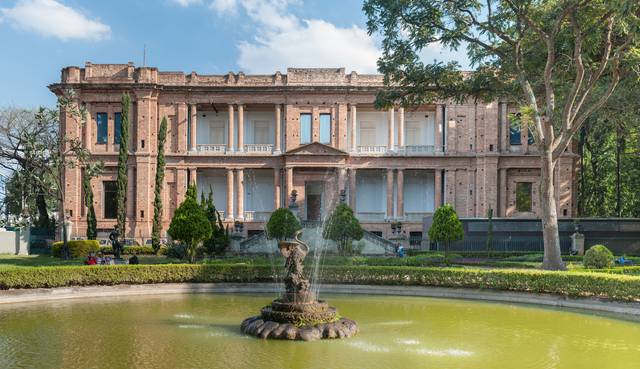
São Paulo's Historic Center met a period of degradation, but it is gradually recovering with recent projects and investments. Even through it still has some problems, it is an area to not be missed due to its historical and cultural value for the city. Here you can find many constructions and landmarks from glorious moments of São Paulo's history, ridiculously crowded commercial areas, and a multitude of theatres and cultural activities.
The Pinheiros river crosses the West of São Paulo in North-South direction, and although heavily polluted, the neighbourhoods surrounding the river are among the most beautiful and interesting areas of the city. The East shore is filled with skyscrapers that compose the business centers of Faria Lima, Brooklin Novo and Vila Olímpia, and contains the longest cycleway of the city, as well as one of the most vibrant nightlife areas. The West shore is home to University of São Paulo and exhibits a stereotypical portrait of São Paulo's social inequality, contrasting luxurious apartments and mansions with low class suburbs and favelas. In the middle of the river, stands the magnificent Ponte Octavio Frias, more known as Ponte Estaiada. The Line 9-Emerald train line runs alongside the river, making all spots quite easy to reach.
Although São Paulo is commonly associated with gray, concrete, and lack of green space, the Atlantic rainforest still covers large portions of the city and even of the municipality. These green areas are constantly under threat by irregular occupation, so the government has turned many of them into public parks in order to better protect them.
Parks in the city can be divided into three types:
- Leisure parks are those with plenty of recreational, sport and cultural facilities, but do not contain considerable amounts of original vegetation. Parque Ibirapuera (see São Paulo/South Central) is certainly the most famous park of this type in the city, hosting various museums, monuments, and cultural activities. There are also plenty of activities for tourist with guided tours for birdwatch, tree's identification and a general and popular one Discovering the Ibirapuera Park, all managed by Parque Ibirpauera Conservação;
- Ecotourism parks are those which are mostly covered by the Atlantic rainforest and other natural ecosystems, and contain limited recreational facilities. They are suited for those seeking an adventure. These include Parque Estadual da Cantareira (see São Paulo/Northeast and Guarulhos), APA Capivari-Monos (see São Paulo/Far South) and Parque Estadual do Jaraguá (see São Paulo/Northwest).
- Mixed parks are a mix between the two above types: they have both leisure facilities and preserved nature areas. They are a nice option if you think that nature is best enjoyed with the company of other people, or if you want to do something more relaxing and less adventurous. These include Parque do Carmo, Parque Ecológico do Tietê (see São Paulo/Far East) and Horto Florestal (see São Paulo/Northeast).
Check the individual district listings for a more comprehensive list of parks and more detailed information.
Leisure parks are those with plenty of recreational, sport and cultural facilities, but do not contain considerable amounts of original vegetation. Parque Ibirapuera (see [[São Paulo/South Central]]) is certainly the most famous park of this type in the city, hosting various museums, monuments, and cultural activities. There are also plenty of activities for tourist with guided tours for birdwatch, tree's identification and a general and popular one Discovering the Ibirapuera Park, all managed by Parque Ibirpauera Conservação;
Ecotourism parks are those which are mostly covered by the Atlantic rainforest and other natural ecosystems, and contain limited recreational facilities. They are suited for those seeking an adventure. These include Parque Estadual da Cantareira (see [[São Paulo/Northeast]] and [[Guarulhos]]), APA Capivari-Monos (see [[São Paulo/Far South]]) and Parque Estadual do Jaraguá (see [[São Paulo/Northwest]]).
Mixed parks are a mix between the two above types: they have both leisure facilities and preserved nature areas. They are a nice option if you think that nature is best enjoyed with the company of other people, or if you want to do something more relaxing and less adventurous. These include Parque do Carmo, Parque Ecológico do Tietê (see [[São Paulo/Far East]]) and Horto Florestal (see [[São Paulo/Northeast]]).
As the art center of the country, São Paulo offers many museums and cultural centers.
Two museums to not be missed, due to their size, architecture, and historical importance, are Museu do Ipiranga (Southeast) (closed as of May 2019) and Memorial da América Latina (West).
Appreciators of art should also check Museu de Arte de São Paulo (Paulista), Pinacoteca do Estado (Downtown), Instituto Tomio Ohtake, Museu de Arte Contemporânea (West) and Museu de Arte Moderna (South Central).
Check each district section of this guide for a comprehensive list of museums.

São Paulo is a beautiful city seen from above, so spare some time to go to one of the few points where you'll be able to see how far this city extends to, specially at sunset.
- Banespa Tower, Rua João Brícola, 24, Centro. São Bento Metrô station, +55 11 3249-7180. M-F 10AM-5PM. The observation deck is on the 34th floor, 160 m above ground. For many decades, it used to be the highest building in town. There is a small museum on the top of the building. Make sure and bring ID (passport) because it is required for entrance. Free.
- Restaurant Skye, Hotel Unique, Avenida Brigadeiro Luiz Antônio, 4700. On the rooftop of posh Hotel Unique, Skye serves excellent fusion food under the supervision of chef Emmanuel Bassoleil. Good for night views of the area around Ibirapuera Park. Free.
- São Paulo Jockey Club, Av. Lineu de Paula Machado, 1263. There are two bars and a couple of posh restaurants with a great view of the River Pinheiros, especially around 6PM, when you can go straight from work or a busy day walking about to watch the sun set above town. Free.
Banespa Tower, Rua João Brícola, 24, Centro. São Bento Metrô station, +55 11 3249-7180. M-F 10AM-5PM. The observation deck is on the 34th floor, 160 m above ground. For many decades, it used to be the highest building in town. There is a small museum on the top of the building. Make sure and bring ID (passport) because it is required for entrance. Free.
Restaurant Skye, Hotel Unique, Avenida Brigadeiro Luiz Antônio, 4700. On the rooftop of posh Hotel Unique, Skye serves excellent fusion food under the supervision of chef Emmanuel Bassoleil. Good for night views of the area around Ibirapuera Park. Free.
São Paulo Jockey Club, Av. Lineu de Paula Machado, 1263. There are two bars and a couple of posh restaurants with a great view of the River Pinheiros, especially around 6PM, when you can go straight from work or a busy day walking about to watch the sun set above town. Free.
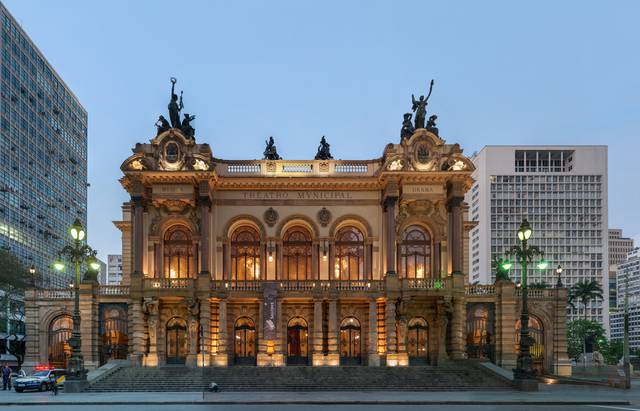 The two most important concert and opera houses of the city are Theatro Municipal and Sala São Paulo (see São Paulo/Historic Center). São Paulo has a great number of theaters, most of which feature plays in Portuguese. The British Cultural Centre, Goethe Institute, Instituto Cervantes and Alliance Française occasionally have plays in English, German, Spanish and French, respectively; check individual District listings.
The two most important concert and opera houses of the city are Theatro Municipal and Sala São Paulo (see São Paulo/Historic Center). São Paulo has a great number of theaters, most of which feature plays in Portuguese. The British Cultural Centre, Goethe Institute, Instituto Cervantes and Alliance Française occasionally have plays in English, German, Spanish and French, respectively; check individual District listings.
The Ciclofaixa de Lazer (Leisure Cycling Lane) comprises dozens of kilometers of interconnected cycling lanes, in the central, south and west areas of the city, that are available on Sundays and some holidays, between 7AM-4PM. It interconnects most places of interest of the city - Downtown, Avenida Paulista, Parque do Ibirapuera, University of São Paulo, the Pinheiros river business centers and the Guarapiranga reservoir, although certainly not using the shortest paths. Bicycle borrowing and renting is available at Parque das Bicicletas (in Parque do Ibirapuera) and at Praça do Ciclista (at Avenida Paulista), but try to get a bicycle in advance if possible.
Since the cycling route is family-oriented, signaling and safety standards are high. The route is stricly intended for recreational, not sportive cycling, so set your speed accordingly in the presence of other cyclists. A full map of the route, as well as other useful information, are available here.
Both adults and kids are ensured to have fun by seeing the animals in the São Paulo Zoo and in the São Paulo Aquarium (see São Paulo/Southeast). São Paulo also has educative spaces aimed both at adults and children, including Catavento Cultural (see São Paulo/Downtown) and Espaço Ciência (see São Paulo/West). Finally, Mundo da Xuxa (see São Paulo/South Central) is a theme park only for the small ones.

Football (soccer) is an inherent part of Brazilian culture, and São Paulo is no exception, being home of four football teams that generally run in the 1st division: Corinthians, São Paulo, Palmeiras and Portuguesa. The five large football stadiums in the city are Morumbi, Allianz Parque (see São Paulo/West), Pacaembu (see São Paulo/Historic Center), Arena Corinthians (also popularly known as "Itaquerão") and Canindé (see São Paulo/Southeast). A word of warning, however: although most matches are safe and fun events, games between the biggest local rivals (Corinthians, São Paulo, Palmeiras and, to a smaller extent, Santos) have had episodes of violence flaring up (in the majority of cases, such incidents happen outside of the stadium), due to a number of violent fans (ultras). Going to such games can be a risky proposition. Portuguese games are safe, have few supporters, and are very peaceful and curious (meets the Portuguese community in the city).
- São Paulo Historical City Tour is a panoramic tour for those keen to have an introduction to the history, culture, and the lifestyle of the biggest city in the Southern Hemisphere. The city tour takes about 3 hours, during which the visitor will pass by places in São Paulo's Old Centre and get familiar with attractions such as the Cathedral of Sé, Pátio do Colégio (short stop at the square, the site where the city was founded), Monastery of São Bento, the Banespa Building (São Paulo’s answer to the Empire State Building), the Martinelli Building (the first skyscraper in South America), Viaduto do Chá (Tea Viaduct), the Municipal Theater, Sala São Paulo concert hall, Estaçao da Luz train station and the Municipal Market.
- TurisMetrô. Offer a variety of city tours every weekend. These are mostly walking tours but with some use of the metro. The tour is free of charge, but you will need to take some cash with you to buy metro tickets during the tour as necessary. The tours start at the TurisMetrô desk in Sé metro station at 9AM and 2PM on Saturdays and Sundays; you will need to arrive half an hour earlier to sign up. The desk is inside the ticket turnstiles, so if you arrive by metro don't exit the station past the turnstiles while looking for the desk or you'll have to pay for an extra ticket to get back in. If you are already around the station, you will have to pay for a ticket to gain access to the desk, although you can use it to make the first journey of the tour so it's not wasted. The guides speak English.
São Paulo Historical City Tour is a panoramic tour for those keen to have an introduction to the history, culture, and the lifestyle of the biggest city in the Southern Hemisphere. The city tour takes about 3 hours, during which the visitor will pass by places in São Paulo's Old Centre and get familiar with attractions such as the Cathedral of Sé, Pátio do Colégio (short stop at the square, the site where the city was founded), Monastery of São Bento, the Banespa Building (São Paulo’s answer to the Empire State Building), the Martinelli Building (the first skyscraper in South America), Viaduto do Chá (Tea Viaduct), the Municipal Theater, Sala São Paulo concert hall, Estaçao da Luz train station and the Municipal Market.
TurisMetrô. Offer a variety of city tours every weekend. These are mostly walking tours but with some use of the metro. The tour is free of charge, but you will need to take some cash with you to buy metro tickets during the tour as necessary. The tours start at the TurisMetrô desk in Sé metro station at 9AM and 2PM on Saturdays and Sundays; you will need to arrive half an hour earlier to sign up. The desk is inside the ticket turnstiles, so if you arrive by metro don't exit the station past the turnstiles while looking for the desk or you'll have to pay for an extra ticket to get back in. If you are already around the station, you will have to pay for a ticket to gain access to the desk, although you can use it to make the first journey of the tour so it's not wasted. The guides speak English.
According to the São Paulo Convention & Visitors Bureau, São Paulo hosts 90,000 events a year, from meetings and conferences to sports and cultural events. Events tied to a particular region are listed in the individual district sections. The following events are considered important to the city as a whole:
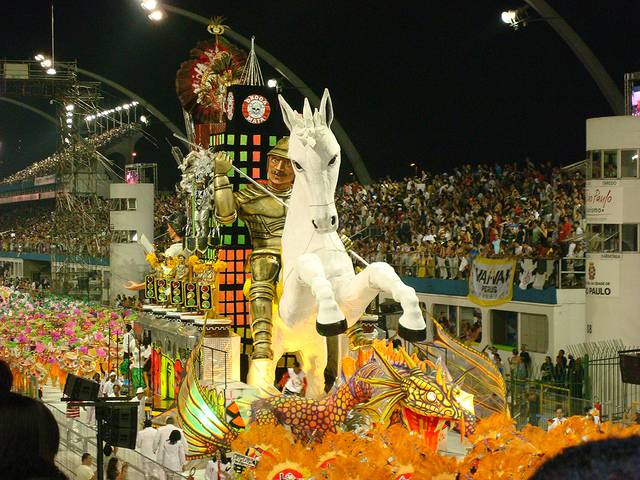
- São Paulo Carnival, Avenida Olavo Fontoura, 1209, Santana (at the Sambódromo from Parque Anhembi, near Armenia and Tiete stations, +55 11 2226-0400. If you're in São Paulo during the annual Carnival, a national bank holiday between the end of February and March. This is where the typical Carnival parade takes place, with dancers dressed up in costumes and musicians play samba songs on the top of fancy cars. If you can afford it, get tickets closest to the "pista" (standing area, close to the parade itself). This will give you a premium view of the parade, and the possibility of comfortably sitting down on benches. Waiters pass to and fro selling chocolate, chips, beer, soft drinks and booze. Another option is to visit one of the various samba schools in town, where you can see the rehearsal concerts of musicians and dancers. You can even have the opportunity to join the parade at the time of Carnival holidays by acquiring the costume from a samba school and getting in touch with the people organising the event in one of the schools. However, São Paulo is not a traditional Carnaval destination for Brazilians, like Rio. The city will usually be less crowded on Carnaval then usual, as Paulistanos leave for the Paulista Coast or other states.
- Gay Pride Parade, Avenida Paulista. Every year, during Corpus Christi holidays (usually between May and June), around 3 million people take part in the largest Gay Pride parade in the world. It takes place on a Sunday, and Avenida Paulista is the spot to head to. Floats bustling with electronic music parade from MASP to República, while every type imaginable marches along. The drinks are plenty and the rave party feel keeps the paraders dancing way pass sunset.
- Virada Cultural. Virada Cultural is a round-the-clock cultural marathon that takes place in various parts of the Historic Center (Downtown), happening yearly around April–May. It is a free event that gathers an audience of several million of people circulating during a 24-hour, non-stop cultural party. Exceptionally, the metro and train work uninterruptedly during the event. During the 2012 edition, there were about 1,300 shows and 15 km of streets were occupied. Free.
- Brazilian Grand Prix, Autódromo José Carlos Pace (Far South. A Formula One championship race which occurs at the Autódromo José Carlos Pace in Interlagos. The Interlagos circuit has created some of the most exciting and memorable races in recent Formula One history, and is regarded as one of the most challenging and exciting circuits on the F1 calendar. Along with Spa-Francorchamps, it is rare in that the circuit in its modern form is one of the few with a lengthy history in the sport not considered to have lost much of its mystique or challenge in its adaptation for the modern, much more safety-conscious era of 21st century Formula One.
São Paulo Carnival, Avenida Olavo Fontoura, 1209, Santana (at the Sambódromo from Parque Anhembi, near Armenia and Tiete stations, +55 11 2226-0400. If you're in São Paulo during the annual Carnival, a national bank holiday between the end of February and March. This is where the typical Carnival parade takes place, with dancers dressed up in costumes and musicians play samba songs on the top of fancy cars. If you can afford it, get tickets closest to the "pista" (standing area, close to the parade itself). This will give you a premium view of the parade, and the possibility of comfortably sitting down on benches. Waiters pass to and fro selling chocolate, chips, beer, soft drinks and booze. Another option is to visit one of the various samba schools in town, where you can see the rehearsal concerts of musicians and dancers. You can even have the opportunity to join the parade at the time of Carnival holidays by acquiring the costume from a samba school and getting in touch with the people organising the event in one of the schools. However, São Paulo is not a traditional Carnaval destination for Brazilians, like Rio. The city will usually be less crowded on Carnaval then usual, as Paulistanos leave for the [[Paulista Coast]] or other states.
Gay Pride Parade, Avenida Paulista. Every year, during Corpus Christi holidays (usually between May and June), around 3 million people take part in the largest Gay Pride parade in the world. It takes place on a Sunday, and Avenida Paulista is the spot to head to. Floats bustling with electronic music parade from MASP to República, while every type imaginable marches along. The drinks are plenty and the rave party feel keeps the paraders dancing way pass sunset.
Virada Cultural. Virada Cultural is a round-the-clock cultural marathon that takes place in various parts of the Historic Center ([[São Paulo/Downtown|Downtown]]), happening yearly around April–May. It is a free event that gathers an audience of several million of people circulating during a 24-hour, non-stop cultural party. Exceptionally, the metro and train work uninterruptedly during the event. During the 2012 edition, there were about 1,300 shows and 15 km of streets were occupied. Free.
Brazilian Grand Prix, Autódromo José Carlos Pace (Far South. A Formula One championship race which occurs at the Autódromo José Carlos Pace in Interlagos. The Interlagos circuit has created some of the most exciting and memorable races in recent Formula One history, and is regarded as one of the most challenging and exciting circuits on the F1 calendar. Along with Spa-Francorchamps, it is rare in that the circuit in its modern form is one of the few with a lengthy history in the sport not considered to have lost much of its mystique or challenge in its adaptation for the modern, much more safety-conscious era of 21st century Formula One.
You can find practically anything in São Paulo. Imported goods can be expensive, but look out for Brazilian-made bargains in all categories. Spend some time in one of the many "shoppings" (as Brazilians call the shopping malls) and also look out for areas with shops catering for specific interests.
Remember that street shops usually operate 10AM-6PM, including Saturdays (when they close earlier), but are closed on Sundays. The countless shopping malls operate M-Sa 10AM-10PM and Su 10AM-8PM.
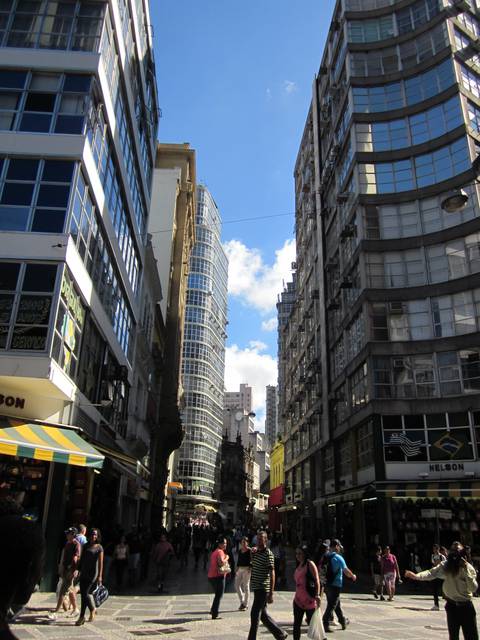
The area between Avenida Ipiranga and Parque Dom Pedro II (Downtown) is the closest to what São Paulo has from a "central shopping area", with various pedestrianized and non-pedestrianized shopping streets. The exceptionally crowded Rua 25 de Março, with its diverse range of bargains, is perhaps the most famous commercial street of the area.
Avenida Paulista and Rua Augusta (Paulista) form a smooth transition between the popular commerce of Downtown and the affluent commerce of Rua Oscar Freire (West).
São Paulo has also many specialized shopping areas, such as Rua Teodoro Sampaio (West) for furniture and musical instruments, Rua José Paulino (Downtown) and Brás neighborhood (Southeast) for bargain and wholesale clothing, Liberdade neighbourhood (Downtown) for cosmetics and Asian products, and Rua Santa Ifigênia (Downtown) for electronic equipment.
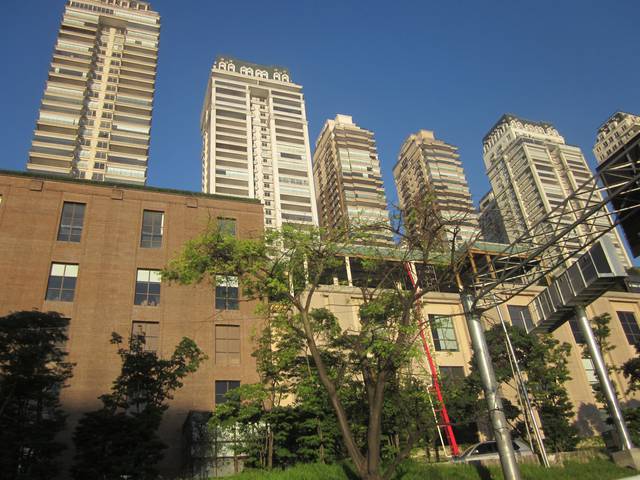
Paulistanos, especially those with higher income, have an indoor shopping culture. The fear of criminality, traffic and São Paulo's unpredictable weather are strong factors to this. Shopping malls in São Paulo are not only centers of "shopping" but also leisure areas, typically offering spaces for kids, cinemas, food courts, and sometimes even theatres, expositions, and sport areas. Many shopping malls in São Paulo also offer miscellaneous services such as banks, laundry, repairs, and sometimes even police stations and doctors.
The selection of shops of a mall depends on the type of public predominant in the surroundings: at shopping malls located at working-class neighborhoods, it is easier to find bargain department stores, while shopping malls in wealthy areas may be the only way to have access to exclusive designer stores. Check the individual district listings for a comprehensive list of shopping malls in the city.
Some shopping malls that deserve special mention are Morumbi/Market Place (South Central - with more than 600 shops and dozens of restaurants), Eldorado (West - with an immense food court), Iguatemi (West - the oldest shopping mall of São Paulo, with very upscale profile), JK Iguatemi (West - the newest shopping mall for the wealthy Paulistanos), Cidade Jardim (West - famous for its internal gardens), Aricanduva (Far East - the city's largest and most famous working class shopping mall), and Frei Caneca (Downtown - the favorite of the LGBT public).
Far from Downtown, there are many suburban shopping areas. The busiest of them is probably the area around Largo 13 de Maio (South Central), the "central shopping area" of the former city of Santo Amaro, now part of São Paulo.
There are also the open markets (feiras livres) and municipal markets (where you can buy fresh and cheaper fruit, vegetables and meat), supermarkets and atacados (a type of supermarket where you pay less if buy at least a certain quantity, very convenient for families).
Most of these local commerce centers are not listed in this guide, but they are of extreme importance in the daily life of Paulistanos.
São Paulo has the highest living cost in the Americas, and it's the 10th most expensive city in the world, according to the Mercer Worldwide Cost of Living 2011 Survey. However, it should be remarked that such rankings are based on averages, which hardly describe a city as huge and with so many contrasts as São Paulo.
It is absolutely possible to enjoy the city's attractions while spending a moderate amount of cash in both accommodations and food. For example, a set meal, drinks included, in a reasonably good place is around R$43. Ask locals for tips how to make the best out of your money if you're on a tight budget.
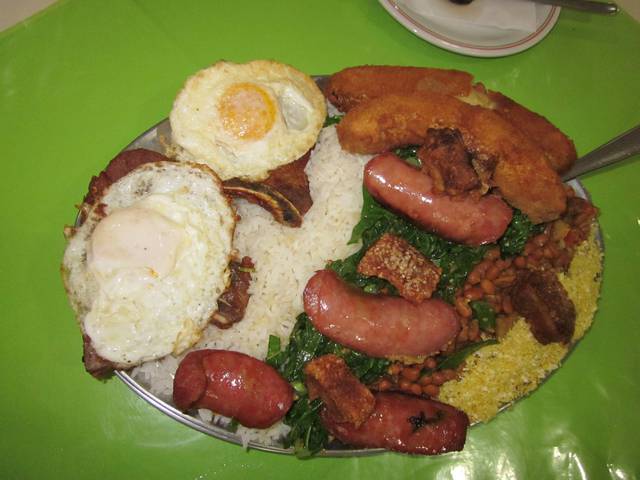 São Paulo is home to a superb diversity of restaurants and cuisines, where you can enjoy typical dishes from literally all over the world. The price range is as wide as the diversity of the restaurants in the city, from cheap snacks and meals in simple and cozy restaurants and food tents in popular markets, to the hugely expensive high end cuisine and internationally recognized restaurants, such as D.O.M, which was (in 2012) named the 4th best restaurant in the world and the best in South America by The World's 50 Best Restaurants.
São Paulo is home to a superb diversity of restaurants and cuisines, where you can enjoy typical dishes from literally all over the world. The price range is as wide as the diversity of the restaurants in the city, from cheap snacks and meals in simple and cozy restaurants and food tents in popular markets, to the hugely expensive high end cuisine and internationally recognized restaurants, such as D.O.M, which was (in 2012) named the 4th best restaurant in the world and the best in South America by The World's 50 Best Restaurants.
The city is also home to a vast array of Brazilian and international fast-food chains, offering varying options ranging from burgers, to sushi and kebab. The fast-food chain Habib's, which originated in São Paulo, is the favorite of lower class Paulistanos due to its cheap "Arab-Brazilian" snacks.
In São Paulo, the ever-present beans-and-rice accompaniment typically involves brown beans instead of black beans, as in Rio. Another local specialty in São Paulo is the Virado à Paulista, which consists of rice, tutu de feijão (a paste of beans and manioc flour; sometimes made of corn flour, in order to be drier than the manioc flour one), kale sautéed with garlic (couve) and pork chops, typically bisteca. It is usually accompanied by pork rinds, bits of sausage, a fried egg and a fried banana.
One dish that claims its local character is the bauru sandwich, allegedly created by a druken student from the University of São Paulo's law school at the Ponto Chic restaurant after a long night out. It consists of four types of melted cheese and sliced roastbeef, and it still endures as one ubiquitous snack in padarias (Brazilian-style eateries).
Japanese restaurants of the rodizio style are found pretty much everywhere, but mainly in the past decade, São Paulo became world famous for its excellent Japan-like and fusion restaurants, including ramen and udon shops and exquisite sushi and sashimi sets, which sometimes even come at a reasonable price. Many of these types of restaurants can be found down rua Tomaz Gonzaga in Liberdade, where connaisseurs of good food have already found their way in. On weekends, these restaurants can be packed, so arrive early to avoid queues.
Another typical type of restaurant in São Paulo are the world-famous churrascarias, where an enormous range of meats and cuts comes to your table by the stick; they also offer a range of sides and salads. In those places, you can eat as much as you want, paying a single fee whose price range may vary from R$45 to R$115. This system is called rodízio, and it has been very successful in the city, spreading to other types of cuisine like Italian, where you can find the rodízio de pizza and Japanese, with the rodízio de sushi.
The cuisine of São Paulo shows the influence of European, Middle Eastern and Asian immigrants. The majority of immigrants in São Paulo arrived from Italy, and other European countries like Portugal, Spain and Germany. There are also large numbers of Asian and Middle Eastern immigrants from Japan, Lebanon and many other countries. Therefore, it is possible to find a wide array of cuisines in the city of São Paulo. Pizza is a particularly popular dish, which can be found with an endless range of toppings, and paulistas will swear their city has the best pizza in the country, if not in the world.
When eating out, a tip of 10 percent on the value of the bill is usually included. Some restaurants don't include this service charge (when you may come across the message "Serviço não incluso" at the end of the bill), but unless the staff are upsettingly rude, do pay the standard 10 percent tip as it is usually part of their wages.
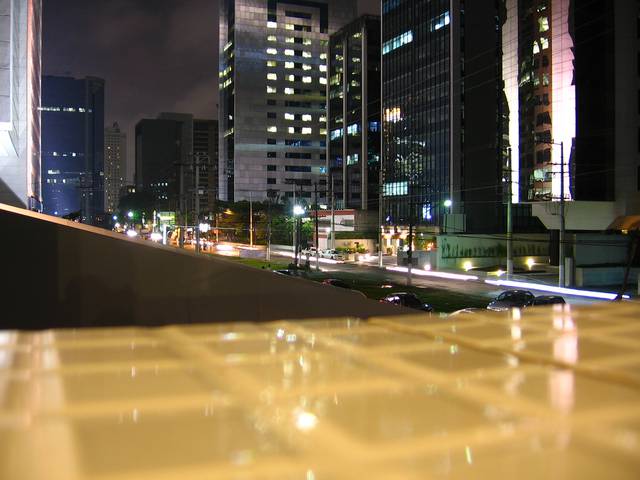 You will have no trouble finding bars in São Paulo, where you can enjoy an ice cold beer, a shot of cachaça or a caipirinha - or anything else for that matter. A chopp (a 300 ml glass of draught beer) will set you back between R$3 and R$10 (in extreme cases), depending on the bar, but anything around R$4, R$5 is fine. Vila Madalena and Itaim have a very high concentration of bars, and are great spots for an all-nighter. For specific suggestions of bars, check the district section.
You will have no trouble finding bars in São Paulo, where you can enjoy an ice cold beer, a shot of cachaça or a caipirinha - or anything else for that matter. A chopp (a 300 ml glass of draught beer) will set you back between R$3 and R$10 (in extreme cases), depending on the bar, but anything around R$4, R$5 is fine. Vila Madalena and Itaim have a very high concentration of bars, and are great spots for an all-nighter. For specific suggestions of bars, check the district section.
This city has an unbelievably rich and diverse night life, and is able to provide entertainment for all tastes, from traditional samba-rock live music to electro-pop night clubs, raves and even some fetish clubs. It is worth planning at least one night out while you're in town. On the other hand, São Paulo's nightlife can be quite expensive; most clubs charge an entrance fee. Usually, entrance hovers around R$25, but they can be over R$250 (US$145) in some upscale places.
The main areas for nightlife in the city are Vila Olímpia, Vila Madalena, and Barra Funda (West), Moema (South Central), Tatuapé and Mooca (Southeast), and Santana (Northeast). The Downtown has also experimented an impressive revival of nightlife. Be sure to check the individual District listings.
Visit this website or buy one of the paper editions to have the latest clubbing updates.
- Public telephone booths can be found on almost every corner of town. They work with phonecards only, which can be bought at any newspaper stand. Regular phonecards allow you to make local and national calls, but the credits fall at an incredible rate if the call is directed to another city or to mobile phones. There is a special phonecard for international calls, so make sure you ask the clerk for the correct one if that's the case.
- The city code (also known locally as the DDD code) for São Paulo is 11), hence local telephone numbers have the following format: +55 11 0000-0000. If you are making local calls, the +55 11 prefix should be dropped.
- When making national calls from SP, you have the option to choose your telephone provider: dial 0 followed by (15) Telefónica, (23) Intelig or (21) Embratel, plus the two-digit DDD code and telephone number.
- When making international calls from São Paulo to abroad, you also have the option to choose your telephone provider: dial 00 followed by (15) Telefónica, (23) Intelig or (21) Embratel, plus the country code and telephone number.
- To make reverse charge calls within the same city code area, dial 90 90 + the telephone number (do not use the city code (11)).
- To make reverse charge calls to other cities, dial 90 followed by (15) Telefónica, (23) Intelig or (21) Embratel, plus the 2-digit DDD code and the telephone number.
Public telephone booths can be found on almost every corner of town. They work with phonecards only, which can be bought at any newspaper stand. Regular phonecards allow you to make local and national calls, but the credits fall at an incredible rate if the call is directed to another city or to mobile phones. There is a special phonecard for international calls, so make sure you ask the clerk for the correct one if that's the case.
Internet cafés (also called cyber cafés or lan houses) can be easily found in every neighborhood.
Also, São Paulo has many open WiFi spots—often you just need to login with Facebook.
People from São Paulo kiss on the right cheek once when they say hello, goodbye and nice to meet you. Some will kiss twice, once on each cheek, a kiss in the air. Men kiss women on the cheek and women kiss women as well, but two men won't give the kiss out unless they're gay or with intimate long-time friends or family. If you feel the occasion is a bit formal, especially on business occasions or if you don't know the person too well, a handshake will do the job. However, if a Paulistano takes the initiative to kiss, make sure you turn your face to the left side to avoid embarrassment.
- Paulistanos do appreciate if you are on time. However, given the infamous traffic congestion that prevails in town, a 15-30 min delay in a meeting is usually tolerated, and you shouldn't worry too much if you or someone else turns up a bit late. In general, do not plan more than two meetings per day, with a possible lunch meeting in between, due to the traffic delay in getting from place to place.
- Office hours are usually from 9AM-6PM, and banks are open M-F 10AM-4PM. However, don't be surprised if a meeting is scheduled after 6PM, as the business culture in São Paulo is a bit workaholic.
- Small gifts are usually gladly accepted, but exchanging presents is not the general rule.
- It is always safer to first adopt a business attire to a meeting—suit and tie for men, business suit for women—even if you turn out to be a bit overdressed in a more informal business environment.
- Before a meeting starts, it is not unusual to have some 5-10 min of informal chat, not related to the business to be discussed (traffic, weather forecasts, and football matches are accepted example topics). To cut short this informal chit chat might appear slightly rude and potentially embarrassing.
São Paulo is the host of one of the biggest Gay Pride parades in the world, attracting every year about 4 million people. Although paulistanos are relatively tolerant to homosexuality, openly public displays of affection between people, especially of same sex are uncommon and likely to attract attention, with the exception of places such as Frei Caneca and Rua Augusta, and at some bars, coffee shops and night clubs. Such displays of affection should be completely avoided in poorer neighborhoods and on public transport, where prejudice is more likely to be openly manifested.
While most people will drive carefully and respecting the rules, you are sure to see some paulistanos cutting you off, crossing where there's no zebra crossings, using bus-exclusive lanes and taking lefts or rights without signalizing their intentions. Bear in mind that if you do this to someone, they might just not care, but some could sound the horn, show you the finger, or even get out the car to physically confront you. That said, it's always best to avoid arguments.
São Paulo, once one of the most violent cities of Brazil, has managed to drastically reduce crime during the 2000s. According to the Sangari Institute, São Paulo was the safest capital city of Brazil in 2011, in terms of homicide rate.
Unfortunately, that doesn't mean that a visitor can really relax about safety, because São Paulo is simply too large and diverse to be described by average statistics. In fact, two of the most visited areas, Downtown and the Pinheiros subprefecture (in the West), have respectively 150% and 50% more violent crime than the city average. Check the individual district listings for safety advice in each area of the city. The general advice is as follows:
- Visitors should avoid walking in deserted areas at night, or at least avoid walking alone. Buses are reasonably safe, but waiting alone at a bus stop at night is not. The metro is always safe, but commuter trains that go to peripheral areas can be dangerous late at night. Be extremely careful when using ATMs at night (or better, do not use them if they are in deserted and dark places. If you really need one, try searching in places like shopping malls, theaters and cinemas and gas stations).
- Driving can sometimes also be risky, especially when you are alone and/or in an upscale bars/clubbing area, like Vila Madalena or Vila Olímpia. If you are driving at night, when stopping for whatever reason (even at a traffic light), check your surroundings. Keep your doors locked and windows closed during the night. If possible, when going back late to the hotel, take a cab or ride with a group of friends. During the day, keep valuable objects away from the window (even if you are using a taxi).
- Some areas can be dangerous even during the day. These include run-down areas, like favelas and areas populated by drug addicts. The last can be easily recognized by the presence of poorly maintained buildings, bad odor, and dirty streets - there are many of those in the Historic Center. Most drug addicts are harmless, but a few may resort to violence to get money to buy their drugs. Contrary to popular belief, nowadays poor neighbourhoods in São Paulo aren't usually dangerous, at least not more dangerous than an ordinary neighborhood. Still, some of them can be dangerous, so if you are in doubt, don't go or have the company of a local.
And naturally, every safety recommendation that applies to big cities in general also applies to São Paulo:
- Don't trust strangers, especially those who seem excessively helpful;
- Always prefer the help of an identified officer or employee to that of a stranger;
- Watch your belongings all the time in crowded streets or public transportation;
- Avoid withdrawing and carrying large amounts of money;
- Avoid using expensive clothes and jewelry that make you stand out.
São Paulo is home to three major football teams in Brazil: Corinthians, Palmeiras and São Paulo. There is also a considerable number of Santos supporters. Minor teams include Portuguesa and Juventus.
Wearing one's favorite club's jersey as casual clothing is usual in São Paulo, even when it's not a match day. While walking by someone wearing a rival's jersey means nothing, being in the "wrong" place at the "wrong" time and with the "wrong" jersey during a match day may be extremely dangerous. For example, if you wear a São Paulo jersey and walk by a group of Corinthians supporters when both clubs are about to face each other, they may provoke you. Some supporters go as far as to schedule street fights on the internet, so it's always best to avoid being near large agglomerations of supporters.
Familiarize yourself with the location of the police stations specializing in tourist service and protection. These stations offer information on public safety and are staffed with qualified professionals to meet your needs.
- Port and Airport Police Division. Special services for tourists and protection for dignitaries. Rua São Bento, 380, 5th floor, Centro. +55 11 3107-5642 and 3107-8332.
- Headquarters of the Specialized Tourist Police – DEATUR. Av. São Luiz, 91, Centro. +55 11 3214-0209 and 3120-3984.
- São Paulo Police Station at Congonhas Airport. Avenida Washington Luis, Moema. +55 11 5090-9032, 5090-9043 and 5090 9041.
- São Paulo Police Station at Cumbica/Guarulhos International Airport. Rua Dr. João Jamil Zarif, Guarulhos. +55 11 6445 3064, 6445-2686, 6445-2162, 6445-3464, 6445-2221.
Port and Airport Police Division. Special services for tourists and protection for dignitaries. Rua São Bento, 380, 5th floor, Centro. +55 11 3107-5642 and 3107-8332.
Headquarters of the Specialized Tourist Police – DEATUR. Av. São Luiz, 91, Centro. +55 11 3214-0209 and 3120-3984.
São Paulo Police Station at Congonhas Airport. Avenida Washington Luis, Moema. +55 11 5090-9032, 5090-9043 and 5090 9041.
São Paulo Police Station at Cumbica/Guarulhos International Airport. Rua Dr. João Jamil Zarif, Guarulhos. +55 11 6445 3064, 6445-2686, 6445-2162, 6445-3464, 6445-2221.
- No vaccination is required for São Paulo, unless you are planning to travel to central-western (Mato Grosso) or northern (Amazon) regions of Brazil afterwards, for which you should take a shot against yellow fever, and carry anti-malaria medication (quinine).
- If you're arriving from Peru, Colombia or Bolivia, the vaccination of yellow fever is required only if you need a visa (i.e., if you are going to stay for longer than 90 days). Check the requirements of any country you will travel to from Brazil.
- Tap water in São Paulo is generally safe, at least when straight from the water supply system. However, several buildings can be lacking in the periodic cleaning of their cisterns and water tanks (the locals themselves tend to avoid tap water and drink bottled or filtered water instead).
In the city of São Paulo the voltage is usually 127V, unlike many other parts of Brazil and even of the São Paulo state. Most electronic products sold in São Paulo are now bi-volt, but always check carefully.
- Australia Australia, Alameda Ministro Rocha Azevedo, 456, 2F, +55 11 2112-6200. 9AM-11AM.
- Argentina Argentina, Ave Paulista, 2313 - sobreloja, +55 11 3897-9522. 9AM-5PM.
- Canada Canada, Ave Nações Unida, 12.901, 16F, +55 11 5509-4321. M-Th 8AM-5PM, F 8AM-1:30PM.
- China China, Rua Estados Unidos, 1071, Jardim América, +55 11 3082-9877. 9AM-1PM.
- Colombia Colombia, Rua Tenente Negrao, 140-7° andar. Cj.92, +55 11 3078-0322-3078-0262. 8AM to 1PM.
- Cuba Cuba, Rua Cardoso de Almedida, 2115, +55 11 2369-8825. 9:30AM-12:30PM.
- the Czech Republic Czech Republic, Ave Morumbi, 635, Jardim Guedala, 05607-000, +55 11-3031-1729.
- France France, Ave Paulista, 1842, Torre Norte, 14F, +55 11 3371 5400. 8:30AM-noon.
- Germany Germany, Ave Brigadeiro Faria Lima, 2092, 12F, +55 11 3097 6644. 8AM-11:30AM.
- Greece Greece, Av. Paulista, 2073, Conjunto Nacional, Ed. Horsa II, 23o andar - cj. 2303, +55 11 3251 0675, +55 11 98138 2129 (Emergencies).
- Israel Israel, Rua James Joule, 92. Brooklin, +55 11 2127 0500.
- Japan Japan, Ave Paulista, 854, 3F, +55 11 3254-0100.
- South Korea Republic of Korea, Ave Paulista, 37, 9F, +55 11 3141-1278. 9AM-5PM.
- Mexico Mexico, Rua Holanda 274 Jardim Europa, +55 11 3576-5400. 8:30AM-11AM.
- Lebanon Lebanon, Ave Paulista, 688, 16F, Bela Vista, +55 11 3262-0604. 9AM-1PM.
- New Zealand New Zealand, Al. Campinas 579, 15F, +55 11 3148-0616. 9AM-1PM.
- Norway Norway, Rua General Almério de Moura, 780, Morumbi, +55 11 3759-2379. 8AM-6PM.
- Russia Russia, Rua Groenlândia, 808, Jardim América, +55 11 3062-6268.
- Spain Spain, Av. Brasil, 948, +55 11 3087-2600. 8:15AM-12:15PM.
- Sweden Sweden, Rua Arandu, 205, Conj 1009, Brooklin Novo, +55 11 5506 9994.
- Switzerland Switzerland, Av. Paulista 1754, 4° andar, Edifício Grande Avenida, +55 11 3372 8200.
- the United Kingdom United Kingdom, Rua Ferreira de Araújo, 741, 2F, +55 11 3094 2700.
- the United States United States, Rua Henri Dunant, 500, Chácara Santo Antônio, +55 11 5186-7000.
Australia Australia, Alameda Ministro Rocha Azevedo, 456, 2F, +55 11 2112-6200. 9AM-11AM.
Argentina Argentina, Ave Paulista, 2313 - sobreloja, +55 11 3897-9522. 9AM-5PM.
Canada Canada, Ave Nações Unida, 12.901, 16F, +55 11 5509-4321. M-Th 8AM-5PM, F 8AM-1:30PM.
China China, Rua Estados Unidos, 1071, Jardim América, +55 11 3082-9877. 9AM-1PM.
Colombia Colombia, Rua Tenente Negrao, 140-7° andar. Cj.92, +55 11 3078-0322-3078-0262. 8AM to 1PM.
Cuba Cuba, Rua Cardoso de Almedida, 2115, +55 11 2369-8825. 9:30AM-12:30PM.
the Czech Republic Czech Republic, Ave Morumbi, 635, Jardim Guedala, 05607-000, +55 11-3031-1729.
France France, Ave Paulista, 1842, Torre Norte, 14F, +55 11 3371 5400. 8:30AM-noon.
Germany Germany, Ave Brigadeiro Faria Lima, 2092, 12F, +55 11 3097 6644. 8AM-11:30AM.
Greece Greece, Av. Paulista, 2073, Conjunto Nacional, Ed. Horsa II, 23o andar - cj. 2303, +55 11 3251 0675, +55 11 98138 2129 (Emergencies).
Israel Israel, Rua James Joule, 92. Brooklin, +55 11 2127 0500.
Japan Japan, Ave Paulista, 854, 3F, +55 11 3254-0100.
South Korea Republic of Korea, Ave Paulista, 37, 9F, +55 11 3141-1278. 9AM-5PM.
Mexico Mexico, Rua Holanda 274 Jardim Europa, +55 11 3576-5400. 8:30AM-11AM.
Lebanon Lebanon, Ave Paulista, 688, 16F, Bela Vista, +55 11 3262-0604. 9AM-1PM.
New Zealand New Zealand, Al. Campinas 579, 15F, +55 11 3148-0616. 9AM-1PM.
Norway Norway, Rua General Almério de Moura, 780, Morumbi, +55 11 3759-2379. 8AM-6PM.
Russia Russia, Rua Groenlândia, 808, Jardim América, +55 11 3062-6268.
Spain Spain, Av. Brasil, 948, +55 11 3087-2600. 8:15AM-12:15PM.
Sweden Sweden, Rua Arandu, 205, Conj 1009, Brooklin Novo, +55 11 5506 9994.
Switzerland Switzerland, Av. Paulista 1754, 4° andar, Edifício Grande Avenida, +55 11 3372 8200.
the United Kingdom United Kingdom, Rua Ferreira de Araújo, 741, 2F, +55 11 3094 2700.
the United States United States, Rua Henri Dunant, 500, Chácara Santo Antônio, +55 11 5186-7000.
The city of São Paulo is only one hour driving from the Paulista Coast, which is a typical Brazilian region full of splendid beaches and great seafood. The young and the old of São Paulo alike head there on the weekends to enjoy the sand, sun and fun. The telephone code changes from 11 to 12 (northern coast - São Sebastião and remaining cities to the north) or 13 (Bertioga and remaining cities to the south) as you travel from Greater São Paulo to the Paulista Coast. All coded from 14 to 19 are upstate São Paulo. The rich agricultural state offers winter destinations, upscale retreats and large Rodeos.
In parenthesis the typical duration of the journey by car (using the fastest route in good traffic conditions) is listed. During long holidays (like Carnival and New Year), expect to be much more.
- Santos (1 hr) - Estuary city near São Paulo, home to Pelé's famous football team Santos F.C. and Brazil's most important seaport.
- Guaruja (1h) - Many Paulistanos have their beach houses in this town, which becomes packed with tourists during the summer months of December, January and February.
- Peruíbe (1½ hr) - Last south coast city nearby São Paulo, home of the Juréia-Itatins Ecological Station, the biggest Atlantic jungle in the state.
- Bertioga (2 hr): just NE of Santos and Guaruja, this beach town hosts a variety of annual festivals, including a Japanese, an Italian and a Native Brazilian. Don't miss the waterfall on the way down the mountain (via Moji das Cruzes), as there's no access on the return trip.
- São Sebastião (2½ hr) - Second in preference for summer houses, the beaches of São Sebastião are a mixture of rustic paradisiac nature with first class night life. Contains one of the most famous beaches of the São Paulo coast, Maresias.
- Ubatuba (3 hr) - Beautiful beaches are the main attraction of this place, as well as its well-preserved nature. Hotels sometimes provide leisure activities such as scuba diving, mountain biking and trekking. The city is known for providing a good surfing environment.
- Ilhabela (3½ hr) - Accessible only from São Sebastião by ferry, it is an archipelago with various savage beaches and ecotourism options.
[[Santos]] (1 hr) - Estuary city near São Paulo, home to Pelé's famous football team Santos F.C. and Brazil's most important seaport.
[[Guaruja]] (1h) - Many Paulistanos have their beach houses in this town, which becomes packed with tourists during the summer months of December, January and February.
[[Peruíbe]] (1½ hr) - Last south coast city nearby São Paulo, home of the Juréia-Itatins Ecological Station, the biggest Atlantic jungle in the state.
[[Bertioga]] (2 hr): just NE of Santos and Guaruja, this beach town hosts a variety of annual festivals, including a Japanese, an Italian and a Native Brazilian. Don't miss the waterfall on the way down the mountain (via Moji das Cruzes), as there's no access on the return trip.
[[São Sebastião]] (2½ hr) - Second in preference for summer houses, the beaches of São Sebastião are a mixture of rustic paradisiac nature with first class night life. Contains one of the most famous beaches of the São Paulo coast, Maresias.
[[Ubatuba]] (3 hr) - Beautiful beaches are the main attraction of this place, as well as its well-preserved nature. Hotels sometimes provide leisure activities such as scuba diving, mountain biking and trekking. The city is known for providing a good surfing environment.
[[Ilhabela]] (3½ hr) - Accessible only from [[São Sebastião]] by ferry, it is an archipelago with various savage beaches and ecotourism options.
- São Roque (1 hr) - A small city mainly regarded as a wine tourism destination, but also containing interesting historical constructions and beautiful nature.
- Itu (1hr 15min) - Historical city that was the birthplace of Brazilian Republic, and with a theme of "oversized things".
- Campos do Jordão (2 hr) - Charming little town in the mountains, at 1,600 m high. Well-off Paulistanos buy their winter house in Campos do Jordao, due in part to the famous winter classic music festival in July, when the high season takes place in town. Many upscale club and bar owners go up the mountain and promote events and parties at this time of the year.
- São Luiz do Paraitinga (2 hr) - City in the Serra do Mar, offering ecoutourism options and an impressive historic center, a national heritage site.
- Aparecida (2 hr) - A major Christian pilgrimage destination, containing the second largest Catholic temple in the World.
[[São Roque]] (1 hr) - A small city mainly regarded as a [[wine tourism]] destination, but also containing interesting historical constructions and beautiful nature.
[[Itu]] (1hr 15min) - Historical city that was the birthplace of Brazilian Republic, and with a theme of "oversized things".
[[Campos do Jordão]] (2 hr) - Charming little town in the mountains, at 1,600 m high. Well-off Paulistanos buy their winter house in Campos do Jordao, due in part to the famous winter classic music festival in July, when the high season takes place in town. Many upscale club and bar owners go up the mountain and promote events and parties at this time of the year.
[[São Luiz do Paraitinga]] (2 hr) - City in the Serra do Mar, offering ecoutourism options and an impressive historic center, a national heritage site.
[[Aparecida]] (2 hr) - A major Christian pilgrimage destination, containing the second largest Catholic temple in the World.
- Hopi Hari (1 hr) - A big theme park located in the city of Vinhedo, one hour from São Paulo. It offers many rides, from those for children to the radical ones. Various food, from snacks to à la carte. You can get there by car or shuttle buses from many places.
- Wet'n Wild São Paulo (1 hr), Itupeva (see the Vinhedo article). A water park of the American Wet'n Wild chain, just beside Hopi Hari, with 12 rides and many food shops.
Hopi Hari (1 hr) - A big theme park located in the city of [[Vinhedo]], one hour from São Paulo. It offers many rides, from those for children to the radical ones. Various food, from snacks to à la carte. You can get there by car or shuttle buses from many places.
Wet'n Wild São Paulo (1 hr), Itupeva (see the [[Vinhedo]] article). A water park of the American Wet'n Wild chain, just beside Hopi Hari, with 12 rides and many food shops.
For the cities below, driving times vary widely according to where the journey begins in São Paulo.
- Mogi das Cruzes - A popular destination for rural and ecotourism.
- Embu das Artes - Town just Southwest of São Paulo, known for its talented local artists. If you are looking for authentic Brazilian art, handicrafts, furniture, or just want to browse around some really cool shops, this is the place to go.
- Pirapora do Bom Jesus - Destination of a Catholic pilgrimage that is one of the oldest state's traditions.
- Santana de Parnaíba - City with a valuable Colonial historical center and strong religious traditions.
- Santo André - Containing the English-built village of Paranapiacaba and ecotourism options in the area.
[[Mogi das Cruzes]] - A popular destination for rural and ecotourism.
[[Embu das Artes]] - Town just Southwest of São Paulo, known for its talented local artists. If you are looking for authentic Brazilian art, handicrafts, furniture, or just want to browse around some really cool shops, this is the place to go.
[[Pirapora do Bom Jesus]] - Destination of a Catholic pilgrimage that is one of the oldest state's traditions.
[[Santana de Parnaíba]] - City with a valuable Colonial historical center and strong religious traditions.
[[Santo André]] - Containing the English-built village of Paranapiacaba and ecotourism options in the area.
